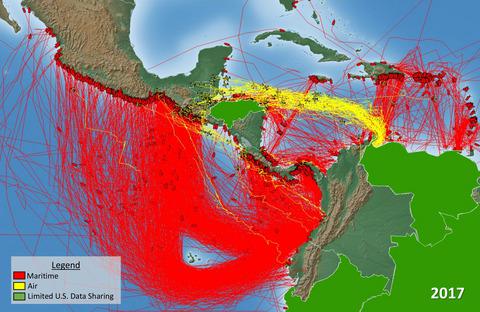Our official English website, www.x-mol.net, welcomes your
feedback! (Note: you will need to create a separate account there.)
Spatialising illicit commodity chains: Comparing coffee and cocaine
Area ( IF 1.6 ) Pub Date : 2021-04-19 , DOI: 10.1111/area.12724 Anayansi Dávila 1 , Nicholas Magliocca 2 , Kendra McSweeney 3 , Ximena Rueda 4
Area ( IF 1.6 ) Pub Date : 2021-04-19 , DOI: 10.1111/area.12724 Anayansi Dávila 1 , Nicholas Magliocca 2 , Kendra McSweeney 3 , Ximena Rueda 4
Affiliation

|
Among geographers, recent focus on the illicit and illegal has tended to fall into two camps. Economic geographers focus on regimes of illicitness and corresponding production of specific forms of economic space; political ecologists and land change scholars, on the other hand, scrutinised how illicit commodity flows shape land and resource use, especially in the global South. This paper offers an initial integration of these two relatively separate subfields, specifically in terms of their complementary attention to uneven development. We use the concept of “global commodity chains” to explore the ways in which the regulation of agricultural commodities shapes how they are trafficked and embed in space, with particular attention to sites of international transshipment. When a commodity is illegal, spaces of transit take on significant analytical importance. As a heuristic, we present a comparative mapping of two agricultural commodity chains linking Colombia and the USA: coffee and cocaine. Their comparison highlights how “illicitness” fundamentally transforms cocaine’s spatiality, requiring risk evasion that results in characteristically enlarged transit spaces and huge differentials between producer and consumer price. We show how rents circulate in those transit spaces, socially and ecologically embedding in diffuse, fluid networks with severe consequences for people and environments. We conclude with implications for work on illicit commodities and the collateral social and environmental harms they produce.
中文翻译:

空间化非法商品链:比较咖啡和可卡因
在地理学家中,最近对非法和非法的关注倾向于分为两个阵营。经济地理学家关注非法制度和特定经济空间形式的相应生产;另一方面,政治生态学家和土地变化学者仔细研究了非法商品流动如何影响土地和资源的使用,尤其是在全球南方。本文提供了这两个相对独立的子领域的初步整合,特别是在它们对不均衡发展的补充关注方面。我们使用“全球商品链”的概念来探索农产品监管如何影响它们的贩运和嵌入太空的方式,尤其是国际转运地点。当商品违法时,交通空间具有重要的分析重要性。作为启发,我们展示了连接哥伦比亚和美国的两条农业商品链的比较图:咖啡和可卡因。他们的比较突出了“非法”如何从根本上改变可卡因的空间性,要求规避风险,从而导致过境空间的扩大以及生产者和消费者价格之间的巨大差异。我们展示了租金如何在这些交通空间中循环,在社会和生态上嵌入分散的、流动的网络,对人和环境造成严重后果。我们总结了对非法商品及其产生的附带社会和环境危害的工作的影响。咖啡和可卡因。他们的比较突出了“非法”如何从根本上改变可卡因的空间性,要求规避风险,从而导致过境空间的扩大以及生产者和消费者价格之间的巨大差异。我们展示了租金如何在这些交通空间中循环,在社会和生态上嵌入分散的、流动的网络,对人和环境造成严重后果。我们总结了对非法商品及其产生的附带社会和环境危害的工作的影响。咖啡和可卡因。他们的比较突出了“非法”如何从根本上改变可卡因的空间性,要求规避风险,从而导致过境空间的扩大以及生产者和消费者价格之间的巨大差异。我们展示了租金如何在这些交通空间中循环,在社会和生态上嵌入分散的、流动的网络,对人和环境造成严重后果。我们总结了对非法商品及其产生的附带社会和环境危害的工作的影响。在社会和生态上嵌入分散的、流动的网络,对人和环境造成严重后果。我们总结了对非法商品及其产生的附带社会和环境危害的工作的影响。在社会和生态上嵌入分散的、流动的网络,对人和环境造成严重后果。我们总结了对非法商品及其产生的附带社会和环境危害的工作的影响。
更新日期:2021-04-19
中文翻译:

空间化非法商品链:比较咖啡和可卡因
在地理学家中,最近对非法和非法的关注倾向于分为两个阵营。经济地理学家关注非法制度和特定经济空间形式的相应生产;另一方面,政治生态学家和土地变化学者仔细研究了非法商品流动如何影响土地和资源的使用,尤其是在全球南方。本文提供了这两个相对独立的子领域的初步整合,特别是在它们对不均衡发展的补充关注方面。我们使用“全球商品链”的概念来探索农产品监管如何影响它们的贩运和嵌入太空的方式,尤其是国际转运地点。当商品违法时,交通空间具有重要的分析重要性。作为启发,我们展示了连接哥伦比亚和美国的两条农业商品链的比较图:咖啡和可卡因。他们的比较突出了“非法”如何从根本上改变可卡因的空间性,要求规避风险,从而导致过境空间的扩大以及生产者和消费者价格之间的巨大差异。我们展示了租金如何在这些交通空间中循环,在社会和生态上嵌入分散的、流动的网络,对人和环境造成严重后果。我们总结了对非法商品及其产生的附带社会和环境危害的工作的影响。咖啡和可卡因。他们的比较突出了“非法”如何从根本上改变可卡因的空间性,要求规避风险,从而导致过境空间的扩大以及生产者和消费者价格之间的巨大差异。我们展示了租金如何在这些交通空间中循环,在社会和生态上嵌入分散的、流动的网络,对人和环境造成严重后果。我们总结了对非法商品及其产生的附带社会和环境危害的工作的影响。咖啡和可卡因。他们的比较突出了“非法”如何从根本上改变可卡因的空间性,要求规避风险,从而导致过境空间的扩大以及生产者和消费者价格之间的巨大差异。我们展示了租金如何在这些交通空间中循环,在社会和生态上嵌入分散的、流动的网络,对人和环境造成严重后果。我们总结了对非法商品及其产生的附带社会和环境危害的工作的影响。在社会和生态上嵌入分散的、流动的网络,对人和环境造成严重后果。我们总结了对非法商品及其产生的附带社会和环境危害的工作的影响。在社会和生态上嵌入分散的、流动的网络,对人和环境造成严重后果。我们总结了对非法商品及其产生的附带社会和环境危害的工作的影响。











































 京公网安备 11010802027423号
京公网安备 11010802027423号